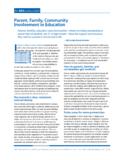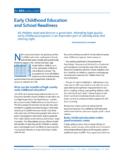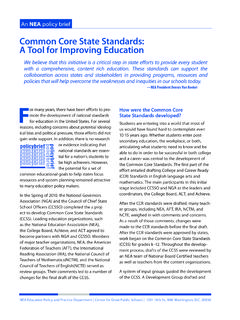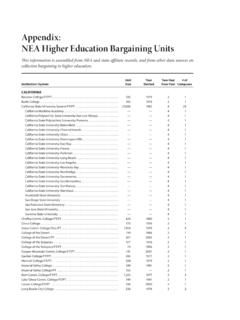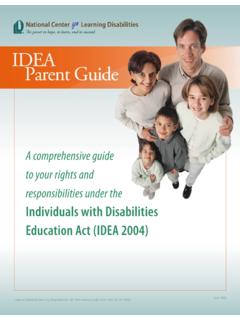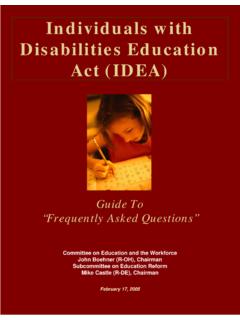Transcription of Disproportionality: Inappropriate Identification of ...
1 An NEA policy brief Disproportionality: Inappropriate Identification of Culturally and Linquistically Diverse Children NEA is dedicated to providing every child with a quality education. That's why we are concerned about disproportionality. Labeling children as disabled when they really are not leads to unwarranted services and reduced expectations. All of us who care about public education educators, administrators, school board members, community decision-makers, and local and state association leaders have an important stake in making sure that children from culturally and linguistically diverse backgrounds receive the supports and programs they need to be successful learners. NEA President Dennis Van Roekel D. isproportionate representation of culturally Significant differences in the proportion of and linguistically diverse (CLD) students in CLD students who are receiving special special education programs has been a education services in more restrictive or concern for nearly four One of the most segregated programs.
2 Complex issues in the field of Excessive incidence, duration, and types of disci- special education today, plinary actions, including suspensions and expul- disproportionality refers to the sions, experienced by CLD students. overrepresentation and under- representation of a particular Some CLD groups are under-represented because the demographic group in special education programs proportions of these students who receive special relative to the presence of this group in the overall services are notably less than the percentage of these student population. Approximately percent of same students in the overall school population. For all students in K 12 schools receive special education example, Hispanics and Asian and Pacific Islanders are services. However, some subgroups of CLD generally under-represented in special education populations receive special services at rates that are programs while American Indians/Alaska Natives are significantly higher or lower than the overall national under-represented in programs for the gifted.
3 Why is disproportionality a concern? Disproportionality exists in various forms and at dif- ferent levels. For example, overrepresentation can be Research suggests that a child 's race and ethnicity present in any or all of these ways: significantly influence the probability that he or she will be misidentified as needing special education and National, state, and district level over- that disproportionality can have immediate and long Identification of CLD students as disabled; term negative Labeling students as disabled Higher incidence rates for certain CLD when they really are not leads to unwarranted services populations in specific special education and supports. Misidentified students are likely to categories, such as mental retardation or encounter limited access to rigorous curricula and emotional disturbance; diminished expectations. And, more importantly, it NEA Education Policy and Practice Department | Center for Great Public Schools | 1201 16th St., NW, Washington, 20036.
4 An NEA policy brief creates a false impression of the child 's intelligence Native, and ELL students with disabilities are more and academic potential. Here's why: likely to be taught in separate classrooms or schools than students who are white or Asian and Pacific Once students are receiving special education In addition, CLD students have higher rates services, they tend to remain in special educa- tion classes. of office referrals, suspensions, and expulsions from school. Often, they receive more severe punishment Students are likely to encounter a limited, less than white students do for the same type of rigorous curriculum. Lower expectations can lead to diminished Contributing Policies and Procedures academic and post-secondary opportunities. A variety of policies, procedures, and practices exist Students in special education programs can at the national, state, district, school, or classroom have less access to academically able peers. levels that can lead to overrepresentation or under- Disabled students are often stigmatized representation of CLD populations in special educa- socially.
5 Tion programs and under-representation in gifted Disproportionality can contribute to signifi- and talented programs. cant racial separation. In an effort to define the issue of disproportionality more clearly, Congress included provisions in the Who Really Is Disabled? Individuals with Disabilities Education Act (IDEA). African-American students who are viewed as that require states and school districts to collect and having challenging behaviors are referred publicly report data on race and ethnicity in these more often for special education programs for circumstances: emotional . the various disability categories assigned to American Indiana/Alaska Native children students;. receive special education labels and services at the restrictiveness of class and school twice the rate of the general student placements of all students with disabilities;. population. 2. Asian and Pacific Islander students are less the incidence, duration, and type of likely to be identified for special education but disciplinary actions, including suspensions and are overrepresented in gifted and talented pro- expulsions experienced by all students.
6 Researchers have found that some specific state poli- English-language learners (ELL) are more likely to receive special education services in school cies and procedures contribute to disproportionality. districts with relatively small ELL populations For example, differences in how states define special than in districts with large education categories, such as specific learning disabili- ties and emotional disturbance, and state special edu- cation eligibility criteria can influence the procedures used to identify students as disabled. 5 When school Discipline and segregated classes polices or procedures strain needed supports or Studies show that CLD students with disabilities are restrict options for students, disproportionality can be often educated in more segregated or restrictive intensified. For instance, funding policies that create environments than their white peers. For example, large general education class sizes or constrict the African-American, Hispanic, American Indian/Alaska availability of early intervention programs and support 2 NEA Education Policy and Practice Department | Center for Great Public Schools | 1201 16th St.
7 , NW, Washington, 20036. An NEA policy brief services impede the ability of teachers to give students 3. de Valenzuela, , Copeland, C. Huaqing Qi, &. the personalized attention they need. Also, rigid disci- M. Park,. Examining Educational Equity: Revisiting the pline policies, such as zero tolerance rules, may inad- Disproportionate Representation of Minority Students in vertently promote lower tolerance for cultural Special Education. Exceptional Children 72, no. 4 (2006): differences. This, in turn, can increase discipline-related 425-441; Keller-Allen, C., English Language Learners with referrals of CLD students. Disabilities: Identification and Other State Policies and Issues, (Alexandria, Va.: Project Forum, National Association of State Call to action Directors of Special Education, 2006). All stakeholders classroom teachers, parents, and 4. Cartledge, G., Tam, Loe, Miranda, community leaders, school and district decision mak- Lambert, Kea, & E. Simmons-Reed, Culturally and ers, and state and federal policymakers have an Linguistically Diverse Students with Behavioral Disorders, important role in decreasing disproportionality.
8 Work- (Arlington, Va.: Council for Exceptional Children). ing together, we can make changes in state, local, and classroom policies, procedures, and practices so that 5. Harry, B., Klinger, Sturges, & R. Moore, Of Rocks every child , no matter his or her cultural or linguistic and Soft Places: Using Qualitative Methods to Investigate background, receives an appropriate education in a Disproportionality, in Racial inequity in special education, ed. great public school. Losen and G. Orfield, (Cambridge, Mass.: Harvard Educa- tion Press, 2002). References Hollins, , Culture in School Learning, (New Jersey: 1. Gamm, S., Disproportionality in Special Education: Identifying Lawrence Erlbaum Associates, Inc., 1996). Where and Why Overidentification of Minority Students Occurs, (Bethesda, Md.: LRP Publications, in press). Campbell-Whatley, , & R. Gardner III, R., Strategies and Procedures for Designing Proactive Intervention 2. Department of Education, Twenty-fourth Annual Report with Culturally Diverse Population of Students with Emotional or to Congress on the Implementation of the Individuals with Dis- Behavioral Disorders and Their Families/Caregivers, (Arlington, abilities Education Act, (Washington, ).)
9 Va.: Council for Children with Behavioral Disorders, 2002). Resources Building the legacy: A training curriculum on IDEA, disproportionality and overrepresentation module. National Dissemination Center for Children with Disabilities (NICHCY), 2007. : Strategies for closing the achievement gaps. National Education Association. Washington, DC, 2003. The role of general education teachers in the Response-to-Intervention (RtI) process. National Education Association. Washington, DC, 2006. Truth in labeling: Disproportionality in special education. National Education Association. Washington, DC, 2007. Meeting the challenge: Special education tools that work for all kids. Ralabate, P., Washington, DC: NEA. Professional Library, 2002. NEA Education Policy and Practice Department | Center for Great Public Schools | 1201 16th St., NW, Washington, 20036 3. An NEA policy brief 4 NEA Education Policy and Practice Department | Center for Great Public Schools | 1201 16th St., NW, Washington, 20036.
10 2008 (PB02).
